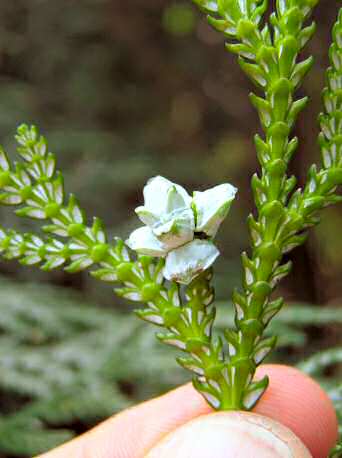|
Japanischer "Hiba"-Lebensbaum
|
Thujopsis dolabrata
Der "Hiba" oder Lebensbaum ist in Japan zu Hause und ist eine immergrüne Nadelbaumart (Konifere). Er ist die einzige Art der Gattung Thujopsis aus der Unterfamilie Cupressoideae bei den Zypressengewächsen. Es gibt viele Synonyme: Thuja dolabrata, Platycladus dolabrata und Dolophyllum dolabratum
|
Japanischer "Hiba"-Lebensbaum
|
In Europa wurde er ab etwa 1853 bekannt. Der langsam wachsende Baum erreicht
eine Höhe von 15 m, auf den Britischen Inseln bis zu 20m.
Die Rinde ist dünn, grau bis rotbraun und löst sich in langen Streifen
ab. Die Krone ist kegelförmig. Die Blätter sind schuppenförmig
und messen ca.6 mal 2mm, sind frischgrün bis gelblichgrün.
|
(links) ...die schuppigen "Blätter" des japanischen "Hiba" Lebensbaums... |
(rechts) |
 |
Der Hiba-Lebensbaum ist einhäusig getrenntgeschlechtig (monözisch). Die Zapfen sind fast kugelförmig mit einem Durchmesser bis 2cm und haben je sechs bis acht Zapfenschuppen.
In verschiedenen Quellen wird entweder der Lebensbaum oder die japanische "Zeder" (s.u.) als Baumaterial für den japanischen Tsugruga-Drachen angegeben. Insofern ist dieser Drachen eine Ausnahme, denn der Rest der japanischen Drachen wird wie allgemein in Südostasien aus verschiedenen Bambus-Arten hergestellt.
Anregungen, Kritik, Fragen......?
...oder weitere wichtige Pflanzen...?
...dann bitte
Mail
to Kite
Musical
Instruments!
Die noch fehlenden Pflanzenbilder werden nach und
nach ergänzt!
Falls jemand gute Pflanzenbilder hat,
würde ich sie hier gerne mit Nennung des Autors veröffentlichen;
Danke im Voraus!!)
Zurück mit dem "back"-button Ihres browsers
oder
zur Index-Seite der "Pflanzen für den Drachenbau"...
oder
Zur Hauptseite von Aeolian Musical Instruments
gestaltet und weiterentwickelt von
Uli
Wahl, all rights reserved
.
.
.
.
.
.
.
.
.
...English version following...
.
.
.
.
.
.
.
.
Thujopsis dolabrata
The "Hiba" or "tree of life" has its home in Japan and belongs to the evergreen trees with needles instead of leaves (conifer). It is the only member of the species of Thujopsis of the family Cypressoideae of the cypressoidae. There are many synonyms: Thuja dolabrata, Platycladus dolabrata and Dolophyllum dolabratum
|
Japanese "Hiba"- tree
|
In Europe known after ca. 1853. The tree grows slowly getting up to 15 m
tall, on the British islands up to 20m.
The bark is thin, grey to red brown and can be torn off in long strips. The
crown is shaped conically, its leaves are sheddy shaped measuring about 6
x 2mm colored in a fresh green to yellowish green.
The cones are nearly bowl.shaped with a diameter up to 2cm with 6-8 cone-sheds each.
|
(links) ...the shed-like "leaves" of Japanese "Hiba"-tree... Botanical Garden Uni-Heidelberg |
(rechts) |
 |
In different sources either the hiba tree or the japanese "cedar" (see this) is used as framing material for the Japanese Tsuruga-kite. In so far this kite is an exception, for the rest of the Japanese kites (and the most of South-East asian kites also) is made of different bamboos; readers knowing more on the Tsuruga-kite, please contact me. Thanks.
Comments, criticism or questions......?
...or some more important plants for kites...?
...please
Mail
to Kite
Musical
Instruments!
Some plant-pictures are still lacking and will be
completed by and by!
In case someone has good pictures,
I'd like to publish them here together with the author's name;
Thanks in advance!!
Go back with the "back"-button of your browser
or
goto the index page of "Plants for Kite-Building"...
or
goto main-page of Aeolian Musical Instruments
created and completed by
Uli
Wahl, all rights reserved